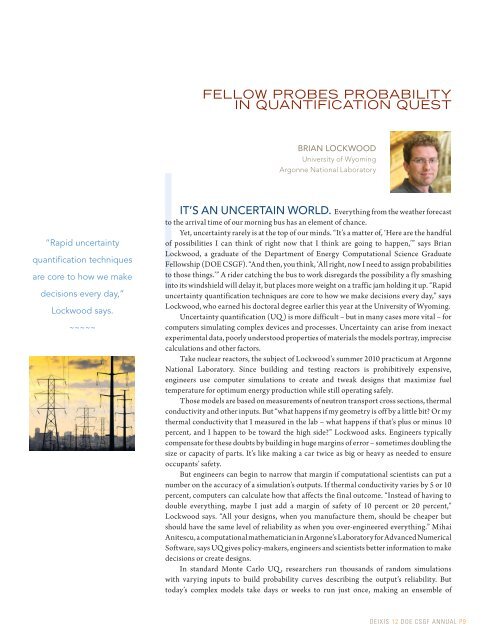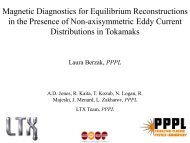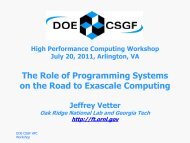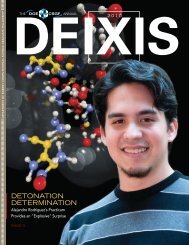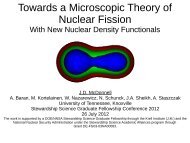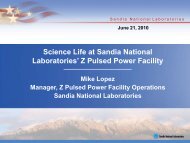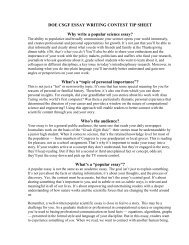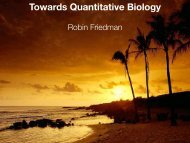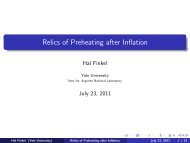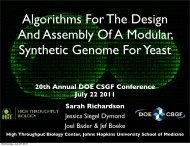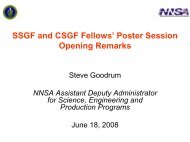2012 - Krell Institute
2012 - Krell Institute
2012 - Krell Institute
You also want an ePaper? Increase the reach of your titles
YUMPU automatically turns print PDFs into web optimized ePapers that Google loves.
FELLOW PROBES PROBABILITY<br />
IN QUANTIFICATION QUEST<br />
“Rapid uncertainty<br />
quantification techniques<br />
are core to how we make<br />
decisions every day,”<br />
Lockwood says.<br />
~~~~~<br />
I<br />
BRIAN LOCKWOOD<br />
University of Wyoming<br />
Argonne National Laboratory<br />
IT’S AN UNCERTAIN WORLD. Everything from the weather forecast<br />
to the arrival time of our morning bus has an element of chance.<br />
Yet, uncertainty rarely is at the top of our minds. “It’s a matter of, ‘Here are the handful<br />
of possibilities I can think of right now that I think are going to happen,’” says Brian<br />
Lockwood, a graduate of the Department of Energy Computational Science Graduate<br />
Fellowship (DOE CSGF). “And then, you think, ‘All right, now I need to assign probabilities<br />
to those things.’” A rider catching the bus to work disregards the possibility a fly smashing<br />
into its windshield will delay it, but places more weight on a traffic jam holding it up. “Rapid<br />
uncertainty quantification techniques are core to how we make decisions every day,” says<br />
Lockwood, who earned his doctoral degree earlier this year at the University of Wyoming.<br />
Uncertainty quantification (UQ ) is more difficult – but in many cases more vital – for<br />
computers simulating complex devices and processes. Uncertainty can arise from inexact<br />
experimental data, poorly understood properties of materials the models portray, imprecise<br />
calculations and other factors.<br />
Take nuclear reactors, the subject of Lockwood’s summer 2010 practicum at Argonne<br />
National Laboratory. Since building and testing reactors is prohibitively expensive,<br />
engineers use computer simulations to create and tweak designs that maximize fuel<br />
temperature for optimum energy production while still operating safely.<br />
Those models are based on measurements of neutron transport cross sections, thermal<br />
conductivity and other inputs. But “what happens if my geometry is off by a little bit? Or my<br />
thermal conductivity that I measured in the lab – what happens if that’s plus or minus 10<br />
percent, and I happen to be toward the high side?” Lockwood asks. Engineers typically<br />
compensate for these doubts by building in huge margins of error – sometimes doubling the<br />
size or capacity of parts. It’s like making a car twice as big or heavy as needed to ensure<br />
occupants’ safety.<br />
But engineers can begin to narrow that margin if computational scientists can put a<br />
number on the accuracy of a simulation’s outputs. If thermal conductivity varies by 5 or 10<br />
percent, computers can calculate how that affects the final outcome. “Instead of having to<br />
double everything, maybe I just add a margin of safety of 10 percent or 20 percent,”<br />
Lockwood says. “All your designs, when you manufacture them, should be cheaper but<br />
should have the same level of reliability as when you over-engineered everything.” Mihai<br />
Anitescu, a computational mathematician in Argonne’s Laboratory for Advanced Numerical<br />
Software, says UQ gives policy-makers, engineers and scientists better information to make<br />
decisions or create designs.<br />
In standard Monte Carlo UQ , researchers run thousands of random simulations<br />
with varying inputs to build probability curves describing the output’s reliability. But<br />
today’s complex models take days or weeks to run just once, making an ensemble of<br />
DEIXIS 12 DOE CSGF ANNUAL P9


